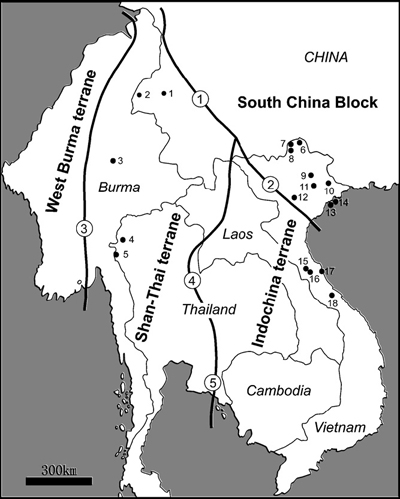Advances on the Middle Palaeozoic vertebrates from Southeast Asia

(Distribution of Siluro-Devonian vertebrate fossil localities in Southeast Asia and western Yunnan. Courtesy of Wang et al.)
The Middle Palaeozoic vertebrate remains from Southeast Asia are distributed in the Shan-Thai (Sibumasu) and Indochina terranes as well as the South China block.
The Shan-Thai terrane includes parts of Burma, Indonesia, Malaysia, Thailand, small segments of China and Vietnam. All Middle Palaeozoic vertebrate remains from this terrane are microfossils, except an incomplete placoderm skull roof from Yingjiang, western Yunnan. The fossil localities include Shidian and Yingjiang of China, Mae Sariang and Mae Sam Lap of Thailand, and Maymyo of Burma.
The Siluro-Devonian vertebrate fauna from Northern Vietnam of the South China block include endemic galeaspids, yunnanolepiforms, and the sarcopterygian Youngolepis, which display a striking similarity to broadly contemporaneous assemblages from Yunnan and Guangxi, China. The early vertebrate fossil localities of this region include Lung Co-Mia Le section, Tong Vai Valley, Khao Loc, Ban Nhuan, Dong Mo, Trang Xa, Lover Song Da area, Do Son Peninsula and Tra Ban Island.
The Indochina terrane includes east Thailand, Vietnam southwest of the Song Ma suture, Cambodia, a large portion of Laos, and small parts of Malaysia and Indonesia. Middle Palaeozoic vertebrate remains are only known from the Vietnamese part of the Indochina terrane, including localities of Cau Rong, Qui Dat, Ly Hoa and My Duc.
The Middle Palaeozoic vertebrates from northern Vietnam accord with those from Yunnan and Guangxi of South China. The fauna from the Si Ka, Bac Bun and Khao Loc formations accords with the coeval Xitun fauna from China, which is characterized by the radiation of Polybranchiaspidiformes, Huannanaspidiformes, Yunnanolepididae, and crown sarcopterygians. Hence, the vertebrates from the Si Ka, Bac Bun and Khao Loc formations of northern Vietnam (also a part of South China block) can be referred to the Xitun fauna.
The vertebrate fauna from lower Song Da area can be referred to the Devonian “galeaspid-yunanolepiform” province, confirming that a separate “Song Da terrane” did not exist in Devonian time. The Do Son Formation can be divided into two distinct sections of Late Silurian and Givetian ages.
Central Vietnam of the Indochina terrane yields vertebrates with South China affinities from the Emsian Ly Hoa Formation and the late Ludlow–early Pridoli Dai Giang Formation. The Dia Giang Formation of My Duc contains the same Late Silurian members, the “Wangolepis”-like placoderm, Psarolepis-like and Guiyu-like osteichthyans, with the Xiaoxiang fauna of China, which is characterized by the early diversification of gnathostomes, in particular the occurrence and divergence of osteichthyans. Therefore, the vertebrates of My Duc should be assigned to the Xiaoxiang fauna, as for those from the lower member of the Do Son Formation. The evidence strongly supports close contact between the Indochina terrane and South China block as early as Ludlow.
The occurrence of thelodont microfossils T. pagoda from Shidian of western Yunnan on the Shan-Thai terrane, with the contemporaneous record of Turinia cf. T. pagoda from South Australia, may indicate a close relationship between Shan-Thai and east Gondwana during the Middle Devonian.
Download attachments: